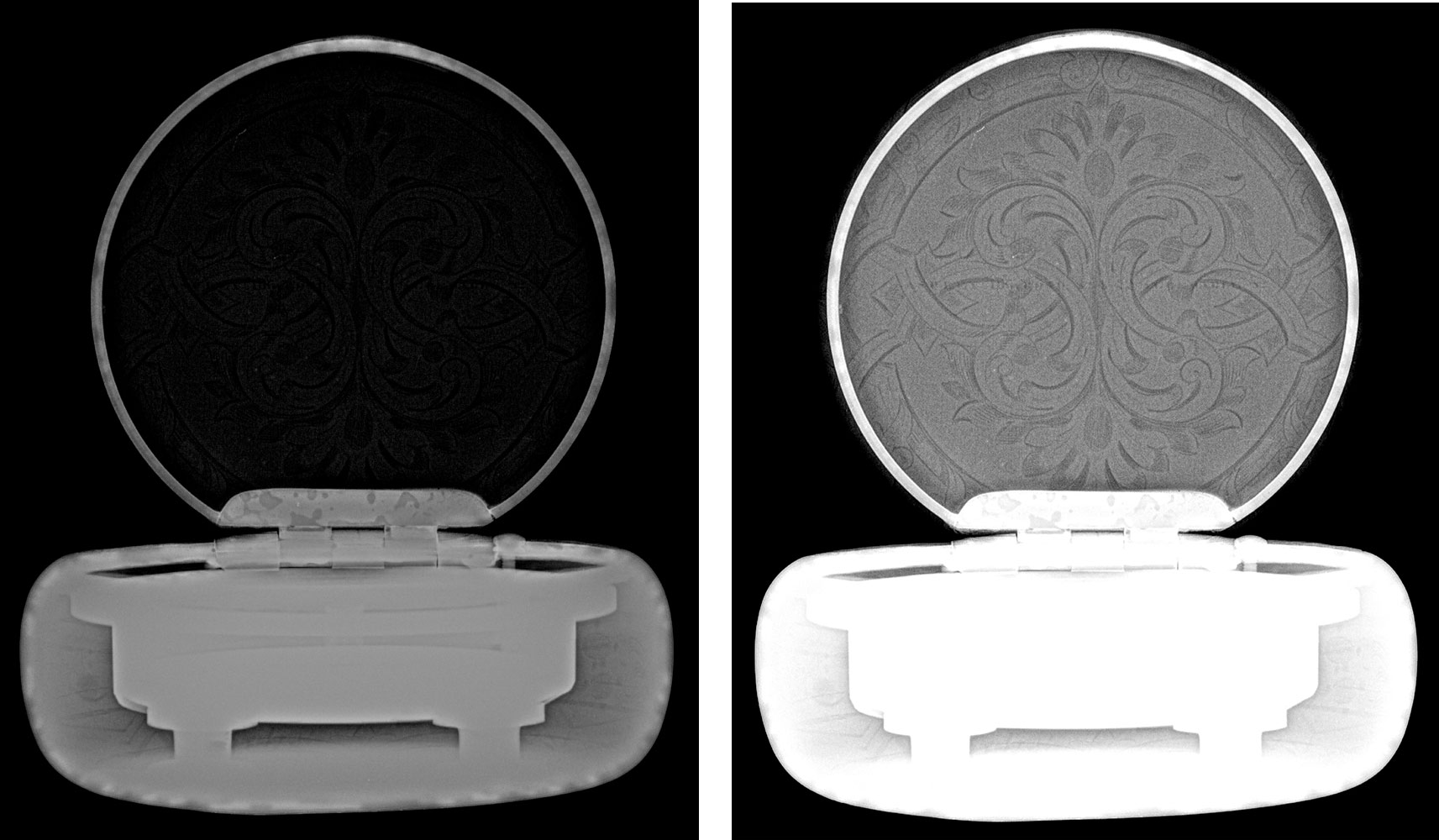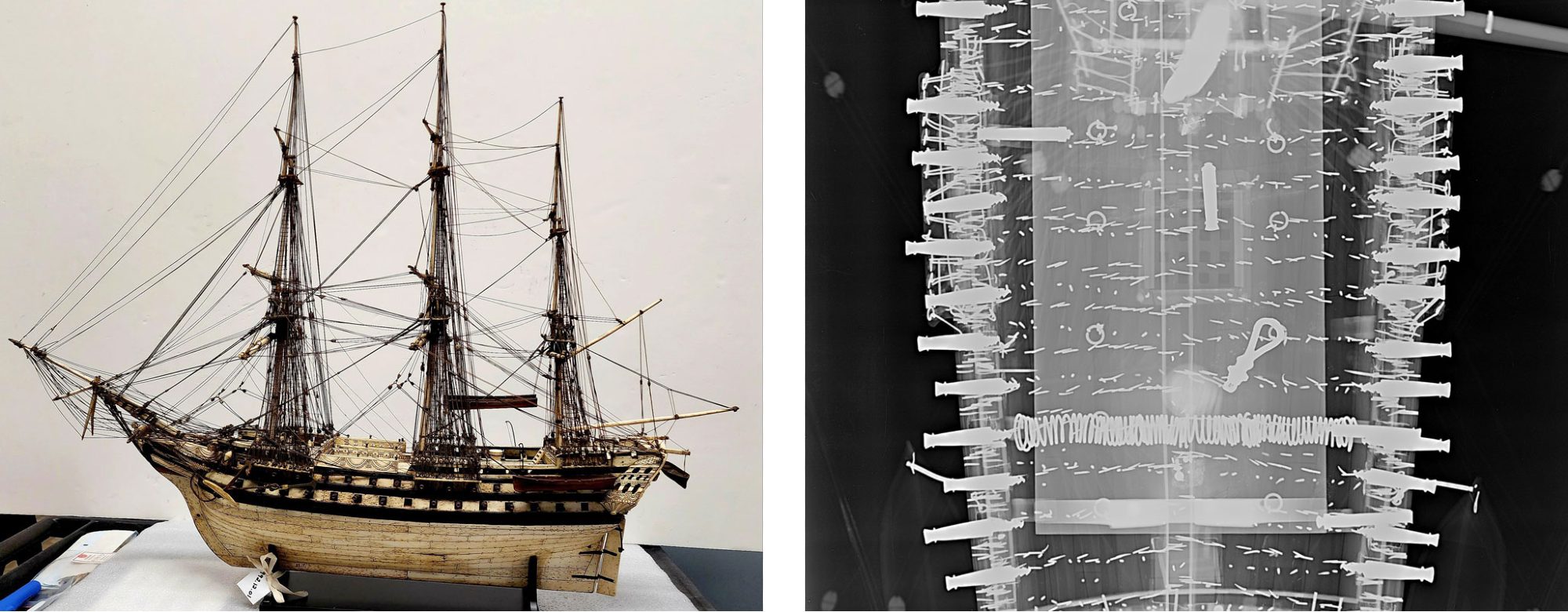Within the Batten Conservation Complex, conservators specializing in archival documents, paper, objects, and archaeological materials are working alongside a research scientist to stabilize and preserve the collection for generations to come.

Left: DÜRR NDT HD-CR 35. Right: D-Tect X Software, showing a radiograph of the stern of a builder’s half model. The Mariners’ Museum and Park, Newport News, Virginia, Half model of a medium clipper ship, 1940.0022.000001. Image Credit: DÜRR NDT GmbH & Co. KG
A team of researchers will continue to expand the body of knowledge discovered in the collection, uncovering the full stories that include the contributions of all cultures to our shared maritime heritage.
As part of this significant research and conservation effort, The Mariners’ Museum recently purchased a DÜRR NDT HD-CR 35 Computed Radiography system and D-Tect X software to replace their radiography capability, which has helped to improve efficiency and flexibility.
The HD-CR 35 is the most advanced and flexible CR scanner currently available today, offering the industry’s highest resolution images. Additionally, its unique TreFoc technology provides an adjustable laser spot size, allowing it to provide high-contrast images when needed.

Image 1. The Mariners’ Museum and Park, Newport News, Virginia, Pocket compass from a dispatch box, 2017.0030.000001R. Image Credit: DÜRR NDT GmbH & Co. KG
Digital imaging technology significantly enhances artifact analysis, as demonstrated by the examination of a copper-alloy pocket compass from an 1872 dispatch box.
By employing a single-energy X-Ray and scanning the imaging plate (IP) into DÜRR NDT’s D-Tect X software, analysts could efficiently explore various density areas within the object. This process was facilitated by the software’s advanced image adjustment tools, which allowed for detailed focus on specific sections without the need for multiple exposures that traditional film radiography would necessitate.
The image on the left showcases the thicker areas of the compass, including the hinge and body, while the subtle engraving on the significantly thinner lid is depicted in the image on the right. Both views are from the same captured image, with minor software adjustments of the viewing parameters used to highlight details in the area of interest.
With imaging capabilities that are this flexible, conservators are able to utilize the same image to investigate tool markings in the engraving and structure/assembly. This would have previously required two separate images.

Image 2. The Mariners’ Museum and Park, Newport News, Virginia, Leather shoe sole, Princess Carolina infill material, 1988.59.42.06. Image Credit: DÜRR NDT GmbH & Co. KG
Image 2 is an X-Ray image of a leather shoe sole retrieved from Princess Carolina, a derelict ship used as fill during land expansion in Manhattan in the mid-18th century. Although the vessel is older than this, especially considering that it is the oldest-known European-style ship constructed in North America, the fill material – like this shoe – dates to the end of the vessel’s life in the mid-18th century.
The HD-CR 35’s imaging of a leather shoe highlights its capabilities in two significant ways. First, it demonstrates the system’s proficiency in capturing detailed images of not only dense materials like metals but also thin organic objects such as leather. Second, the X-Ray image intriguingly reveals initials etched into the leather, details that were not apparent upon a standard visual inspection of the sole. This underscores the value of advanced imaging technology in uncovering hidden features and information in various types of artifacts.
The D-Tect X software’s image processing filters play a crucial role in enhancing the clarity of images by significantly improving contrast. This feature is particularly valuable when examining and analyzing precious artifacts, as it brings out even the most subtle details.

Image 3. The Mariners’ Museum and Park, Newport News, Virginia, Prisoner-of-war model, 74-gun ship-of-the-line, 1992.0012.000001A. Image Credit: DÜRR NDT GmbH & Co. KG
Image 3 is of a model boat built by a prisoner-of-war circa 1801, which consists of a wooden structure with overlays of bone, detailed with bone, iron, baleen, and other materials.
Many of these materials would have been salvaged from food remains, and models of this type were often built to sell, allowing the maker to supplement their meager rations.
Digital X-ray imaging has verified the presence of an internal spring mechanism within the cannon. This mechanism was initially designed to enable the cannon’s deployment or retraction, imitating the firing of a broadside and running out the guns.
This mechanism has not been activated recently for fear of damage, but the X-Ray images will be used to further evaluate its condition and also to locate a missing cannon that may have fallen inside the model.
An additional ongoing initiative at The Mariners’ Museum and Park entails the comprehensive preservation, analysis, and documentation of the USS Monitor, the first iron warship in the US Navy and the first warship in the world commissioned with a rotating gun turret.
The vessel sank off the shore of Cape Hatteras, NC, US, in 1862. Its wreck was discovered in 1973, and the turret was recovered back in 2002. All retrieved materials are currently undergoing conservation efforts at the Museum, marking the world’s most extensive marine archaeological metals conservation project.
Numerous other artifacts from the USS Monitor and other vessels have already undergone X-Ray examination and analysis at The Mariners. Will Hoffman, the Director of Conservation, along with the Conservation team, regularly employs the HD CR-35 and D-Tect X software to provide detailed information about artifacts, thereby uncovering significant aspects of maritime history. Each conservator undergoes training to ensure that they can proficiently operate the equipment before specializing in the study of specific materials.
In regards to the prisoner-of-war model, Senior Objects Conservator Erik Farrell commented, “We are incredibly happy with the image quality we are getting from the HD-CR 35. This new system is helping us learn more about the construction and condition of a wide range of objects and has also vastly simplified our imaging process.”
Founded in 1930, the Mariners’ Museum and Park is an educational, non-profit institution accredited by the American Alliance of Museums, preserving and interpreting maritime history through its collection of ship models, paintings, and other artifacts.

This information has been sourced, reviewed and adapted from materials provided by DÜRR NDT GmbH & Co. KG.
For more information on this source, please visit DÜRR NDT GmbH & Co. KG.